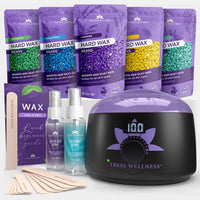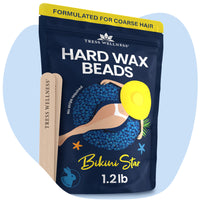Tired of daily shaving and dealing with razor burns? Beard waxing could be the solution you need. This method removes hair from the root, keeping your skin smooth for weeks. Our guide will dive into what beard waxing is, its benefits, how to prepare, the tools you’ll need, the process, and how to handle common concerns.
Key Takeaways
- Beard waxing provides longer-lasting smoothness than shaving, reducing grooming frequency to every four to six weeks, while also exfoliating the skin.
- Proper preparation and aftercare, including cleansing the beard and using soothing lotions post-wax, are crucial for minimizing discomfort and skin irritation.
- Using the right tools, like hard wax for sensitive areas and proper applicators, ensures effective hair removal and reduces the risk of painful experiences or ingrown hairs.
What is Beard Waxing?

Beard waxing is a hair removal technique specifically designed for men’s facial hair removal. Unlike shaving, which only cuts the hair at the surface, waxing removes hair from the root, resulting in longer-lasting smoothness. While it’s not a permanent solution like laser hair removal, many men find that the benefits far outweigh those of traditional shaving.
Over time, facial waxing for waxing facial hair can lead to finer regrowth. This means less stubble and a softer feel, which can be a game-changer for those who struggle with coarse hairs. Plus, the process of waxing also exfoliates the facial skin, providing a two-in-one treatment that leaves your face looking fresher and more refined.
So, why choose waxing over shaving? For starters, it keeps your skin smoother for longer periods, typically four to six weeks. If you’re tired of the daily grind of shaving and dealing with razor burns, beard waxing offers a convenient alternative that leaves your skin feeling soft and looking polished.
Preparing for Beard Waxing

Effective beard waxing starts with proper preparation. Hydrating your skin and cleaning your beard can minimize discomfort and improve results.
Here are the steps to prepare for your waxing session.
Cleansing Your Beard
Cleansing your beard thoroughly before waxing is key. Oils and dirt can hinder wax adherence. Use a mild cleanser to wash away impurities for a smoother experience.
Ensure your beard is completely dry after cleansing. Residual moisture affects wax adhesion, so pat it dry with a towel for better results.
Avoiding Certain Products
Avoid certain skincare products before waxing to prevent skin irritation. Steer clear of retinoids, exfoliants, and products with alcohol or astringent ingredients at least a week in advance.
Such products can increase skin sensitivity and irritation during waxing.
Timing Considerations
Proper timing can enhance waxing results. Schedule your session two to three weeks after your last shave to ensure hair is long enough for removal, ideally between one-fourth to three-fourths of an inch.
Consider your schedule and upcoming events. Avoid waxing right before major events to allow potential redness to subside. Regular sessions every three to six weeks help maintain a polished look.
Tools Needed for Beard Waxing

The right tools are key for a successful beard waxing experience. Gather various types of wax, applicators, and aftercare products for optimal results.
Here are the specific tools you’ll need.
Types of Wax
Choosing the right type of wax is crucial for facial hair. Hard wax, which adheres to hair rather than skin, is gentler and less irritating, ideal for sensitive areas. It provides a more comfortable experience compared to soft wax. Tress Wellness has a few options for you. The original hard wax beads are gentle on the skin and tough on the hair, and the hypoallergenic hard wax beads are perfect for sensitive skin.
Soft wax excels at grabbing fine hairs and may be preferred for specific uses. Regardless of type, ensure the wax is properly warmed for optimal adhesion and effectiveness.
Applicators and Accessories
Proper applicators are crucial for even wax application. Spatulas or sticks of various sizes help spread wax evenly, ensuring proper adhesion and clean removal.
Accessories like waxing strips and tweezers are also vital. Strips remove wax quickly, while tweezers catch any stray hairs.
A mirror and well-lit space make the waxing process smoother and more precise.
Aftercare Products
Post-waxing aftercare is vital for skin health. Soothing sprays or aloe vera gel, can calm the skin and reduce irritation.
Regular use of aftercare products aids recovery and maintains smooth skin. Opt for products with antiseptic properties to prevent infections and keep skin healthy.
The Beard Waxing Process

Beard waxing involves key stages: preparation, wax application, removal, and aftercare. Each step is crucial for optimal results, so let’s break down the process.
Applying the Wax
Correct wax application is essential for effective hair removal. Apply the wax in the direction of hair growth using an applicator at a 45-degree angle to ensure proper adhesion and minimize breakage and ingrown hairs, as well as to support the health of the hair follicle.
Hiring an experienced professional can make a significant difference by ensuring correct wax application, reducing pain, and improving overall effectiveness.
Removing the Wax
Correct wax removal is as important as application. Pull the wax strip quickly against hair growth while keeping skin taut to minimize discomfort and ensure a smooth finish.
Using spatulas for even wax application and waxing strips for efficient removal helps achieve the best results. Quick removal minimizes pain and leaves skin polished and smooth.
Post-Wax Care
Post-wax care is crucial to avoid irritation and ensure smooth skin. Apply aloe vera gel or a soothing lotion immediately after waxing to calm the skin and reduce redness. Keeping the skin clean prevents irritation and infections.
Exfoliate before and after waxing to prevent ingrown hairs by promoting proper hair growth direction. Regularly moisturize the waxed area to maintain hydration and reduce irritation, keeping skin looking its best.
Benefits of Beard Waxing
A major benefit of beard waxing is its long-lasting results. Unlike shaving, which needs frequent maintenance, waxing keeps skin hair-free for four to six weeks, reducing daily grooming time.
Waxing also exfoliates the skin, improving smoothness and appearance. Regular waxing can lead to finer hair regrowth, making your beard softer and more manageable.
Common Concerns and Solutions

Concerns about painful and potential irritation with beard waxing are common. However, effective solutions exist to manage these issues, ensuring a smoother and more comfortable experience.
Here are some common concerns and how to tackle them.
Managing Pain
Managing pain is a common concern. Taking an over-the-counter pain reliever like ibuprofen before waxing can help alleviate discomfort. Proper skin preparation can also reduce pain during the process.
Having a professional perform the waxing can minimize pain. Professionals are skilled in applying and removing the wax quickly, reducing overall discomfort.
Reducing Irritation
Reducing irritation is key for comfort. Applying a soothing lotion or oil immediately after waxing can calm the skin and reduce redness. Cold compresses also help reduce inflammation and promote recovery.
Moisturizers with antiseptic properties, like tea tree oil, can prevent irritation and keep the skin smooth and hydrated. Post-waxing redness is common but usually fades within a day.
Preventing Ingrown Hair
Ingrown hair can be a concern, but proper waxing techniques help prevent them. Waxing removes hair from the root, reducing ingrown hairs compared to shaving. Products with salicylic acid can keep pores clear and reduce the chances of ingrown hairs.
Regular exfoliation and wearing loose clothing after waxing minimize friction and prevent ingrown hair, keeping your skin smoother skin and irritation-free.
Summary
Beard waxing offers numerous benefits, from longer-lasting smoothness to finer hair regrowth and exfoliated skin. Proper preparation, using the right tools, and following the correct waxing techniques can make the process more effective and less painful. With the right aftercare, you can maintain healthy, smooth skin and enjoy the results of your waxing sessions for weeks.
If you’re ready to elevate your grooming routine and enjoy the benefits of beard waxing, follow the tips and techniques outlined in this guide. Happy grooming!
Frequently Asked Questions
How often should I wax my beard?
You should wax your beard every three to six weeks for optimal results and smooth skin. Sticking to this schedule can help keep things looking neat!
Can I wax my beard at home?
You can wax your beard at home, but for a less painful experience and better results, it's really best to seek a professional.
What should I avoid before waxing my beard?
To ensure a smoother waxing experience, steer clear of products with retinoids, exfoliants, and alcohol at least a week prior. This will help minimize irritation and make the process easier on your skin.
How can I reduce pain during beard waxing?
To reduce pain during beard waxing, consider taking an over-the-counter pain reliever like ibuprofen beforehand. This can significantly ease your discomfort.
How do I prevent ingrown hairs after waxing?
To prevent ingrown hairs after waxing, regularly exfoliate, use products with salicylic acid, and opt for loose clothing to minimize friction. Taking these steps can really help keep your skin smooth and irritation-free!




